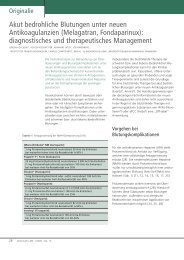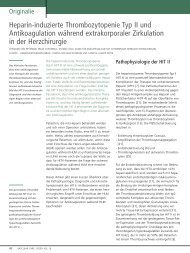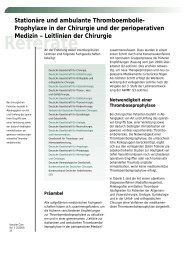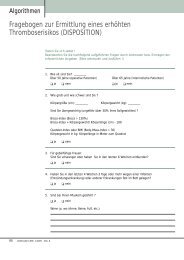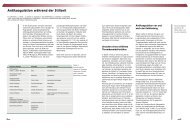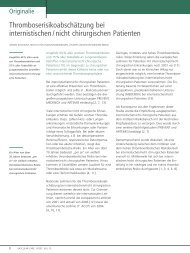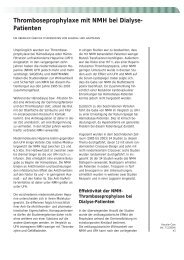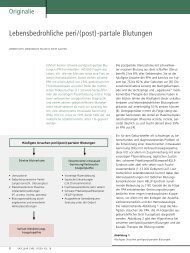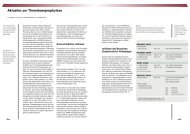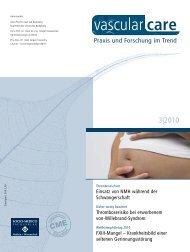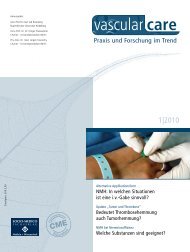HIT Typ II in der operativen Medizin ... - Vascularcare.de
HIT Typ II in der operativen Medizin ... - Vascularcare.de
HIT Typ II in der operativen Medizin ... - Vascularcare.de
- Keine Tags gefunden...
Erfolgreiche ePaper selbst erstellen
Machen Sie aus Ihren PDF Publikationen ein blätterbares Flipbook mit unserer einzigartigen Google optimierten e-Paper Software.
Orig<strong>in</strong>alieCHRISTIAN VON HEYMANN, ORTRUD VARGAS HEIN, MARC KASTRUP, STANISLAO MORGERA, SABINE ZIEMER, CLAUDIA SPIES, CHARITÉ UNVERSITÄTSMEDIZIN BERLIN[97] Mart<strong>in</strong> PY, Chevrolet JC, Suter P, Favre H: Anticoagulation <strong>in</strong>patients treated by cont<strong>in</strong>uous venovenous hemofiltration: aretrospective study. Am J Kidney Dis 24 (1994) 806–12[98] Matthies B, Bürger T, Koch B, Böck M: Hepar<strong>in</strong>-<strong>in</strong>duzierteThrombozytopenie <strong>Typ</strong> <strong>II</strong>: Re-Exposition mit Hepar<strong>in</strong>. Dtsch MedWschr 124 (1999) 1267–70[99] Mazoyer E, Drouet L, Delahousse B, Gruel Y, Rouyrre N: Activatedpartial thromboplast<strong>in</strong> time is more sensitive than ecar<strong>in</strong> clott<strong>in</strong>gtime for monitor<strong>in</strong>g low doses of <strong>de</strong>sirud<strong>in</strong>. Thromb Res 106(2002) 271–72[100] Mehta R, McDonald B, Aguilar M, Ward D: Regional citrate anticoagulationfor cont<strong>in</strong>uous arteriovenous hemodialysis <strong>in</strong> critically illpatients. Kidney Int 38 (1990) 976–81[101] Merz S, Fehr R, Gulke C: S<strong>in</strong>us ve<strong>in</strong> thrombosis. A rare complicationof hepar<strong>in</strong>-<strong>in</strong>duced thrombocytopenia type <strong>II</strong>. Anaesthesist 53(2004) 551–54[102] Meuleman DG: Orgaran (Org 10172): its pharmacological profile<strong>in</strong> experimental mo<strong>de</strong>ls. Haemostasis 22 (2) (1992) 58–65[103] Meyer O, Salama A, Pittet N, Schw<strong>in</strong>d P: Rapid <strong>de</strong>tection of hepar<strong>in</strong>-<strong>in</strong>ducedantibodies with particle gel immunoassay (ID-HPF4).Lancet 354 (1999) 1525–26[104] Monchi M, Berghmans D, Ledoux D, Canivet JL, Dubois B, DamasP: Citrate vs. hepar<strong>in</strong> for anticoagulation <strong>in</strong> cont<strong>in</strong>uous venovenoushemofiltration: a prospective randomized study. IntensiveCare Med 30 (2004) 260–65[105] Morgera S, Scholle C, Voss G, Haase M, Vargas-He<strong>in</strong> O, Krausch D,Melzer C, Rosseau S, Zuckermann-Becker H, Neumayer HH:Metabolic Complications dur<strong>in</strong>g Regional Citrate Anticoagulation<strong>in</strong> Cont<strong>in</strong>uous Venovenous Hemodialysis. S<strong>in</strong>gle CenterExperience. Nephron Cl<strong>in</strong> Pract (<strong>in</strong> press)[106] Newman PM, Chong B: Hepar<strong>in</strong>-<strong>in</strong>duced thrombocytopenia: newevi<strong>de</strong>nce for the dynamic b<strong>in</strong>d<strong>in</strong>g of purified anti-PF4-hepar<strong>in</strong>antibodies to platelets and the resultant platelet activation. Blood96 (2000) 182–87[107] Ofosu FA: Anticoagulant mechanisms of Orgaran (Org 10172)and its fraction with high aff<strong>in</strong>ity to antithromb<strong>in</strong> <strong>II</strong>I (Org 10849).Haemostasis 22 (2) (1992) 66–72[108] Olsson SB: Executive Steer<strong>in</strong>g Committee on behalf of theSPORTIF <strong>II</strong>I Investigators. Stroke prevention with the oral directthromb<strong>in</strong> <strong>in</strong>hibitor ximelagatran compared with warfar<strong>in</strong> <strong>in</strong>patients with non-valvular atrial fibrillation (SPORTIF <strong>II</strong>I): randomisedcontrolled trial. Lancet 362 (2003) 1691–98[109] Palsson R, Niles JL: Regional citrate anticoagulation <strong>in</strong> cont<strong>in</strong>uousveno-venous hemofiltration <strong>in</strong> critically ill patients with a high riskof bleed<strong>in</strong>g. Kidney Int 55 (1999) 1991–97[110] Peeters LLH, Hobbelen PMJ, Verkeste CM:Placental transfer ofOrg 10172, a low molecular weight hepar<strong>in</strong>oid, <strong>in</strong> the awakelate-pregnant gu<strong>in</strong>ea pig. Thromb Res 44 (1986) 277–83[111] Potzsch B, Klovekorn WP, Madlener K: Use of hepar<strong>in</strong> dur<strong>in</strong>gcardiopulmonary bypass <strong>in</strong> patients with a history of hepar<strong>in</strong><strong>in</strong>ducedthrombocytopenia. N Engl J Med 343 (2000) 515[112] Potzsch B, Madlener K, Seelig C, Riess CF, Gre<strong>in</strong>acher A, Muller-Berghaus G: Monitor<strong>in</strong>g of rhirud<strong>in</strong> anticoagulation dur<strong>in</strong>g cardiopulmonarybypass-assessment of the whole blood ecar<strong>in</strong> clott<strong>in</strong>gtime. Thromb Haemost 77 (1997) 920–25[113] Pouplard C, Iochmann S, Renard B, Herault O, Colombat P, AmiralJ, Gruel Y: Induction of monocyte tissue factor expression by antibodiesto hepar<strong>in</strong>-platelet factor 4 complexes <strong>de</strong>veloped <strong>in</strong> hepar<strong>in</strong>-<strong>in</strong>ducedthrombocytopenia. Blood 97 (2001) 3300–302[114] Robson R, White H, Aylward P, Frampton C. Bivalirud<strong>in</strong> pharmacok<strong>in</strong>eticsand pharmacodynamics: effect of renal function, dose,and gen<strong><strong>de</strong>r</strong>. Cl<strong>in</strong> Pharmacol Therap 71 (2002) 433-439[115] Samama MM, Gerotziafas GT: Evaluation of the pharmacologicalproperties and cl<strong>in</strong>ical results of the synthetic pentasacchari<strong>de</strong>(fondapar<strong>in</strong>ux). Thromb Res 109 (2003) 1–11[116] Sarich TC, Eriksson UG, Mattsson C, Wolzt M, Frison L, Fager G,Gustafsson D: Inhibition of thromb<strong>in</strong> generation by the oral directthromb<strong>in</strong> <strong>in</strong>hibitor ximelagatran <strong>in</strong> shed blood from healthy malesubjects. Thromb Haemost 87 (2002) 300–305[117] Sarich TC, Wolzt M, Eriksson UG, Mattsson C, Schmidt A, Elg S,An<strong><strong>de</strong>r</strong>s-son M, Wollbratt M, Fager G, Gustafsson D: Effects ofximelagatran, an oral direct thromb<strong>in</strong> <strong>in</strong>hibitor, rhirud<strong>in</strong> and enoxapar<strong>in</strong>on thromb<strong>in</strong> generation and platelet activation <strong>in</strong> healthymale subjects. J Am Coll Cardiol 41 (4) (2003 Feb 19) 557–64[118] Scher<strong>in</strong>g Arzneimittel<strong>in</strong>formation: Tödlich verlaufene anaphylaktischeReaktionen mit Refludan (Lepirud<strong>in</strong>),(25.10.2002), unter:www.akdae.<strong>de</strong>/20/40/Archiv/2002/96_20021025.pdf[119] Schiffner R, Glaessl A, Landthaler M, Stolz W: Tolerance of <strong>de</strong>sirud<strong>in</strong><strong>in</strong> a patient with generalized eczema after <strong>in</strong>travenous challengewith hepar<strong>in</strong> and a <strong>de</strong>layed-type sk<strong>in</strong> reaction to high andlow molecular weight hepar<strong>in</strong>s and hepar<strong>in</strong>oids. ContactDermatitis 42 (2000) 49[120] Schmahl KS, Ganjoo AK, Harloff MG: Orgaran (Org 10172) forcardiopulmonary bypass <strong>in</strong> hepar<strong>in</strong>-<strong>in</strong>duced thrombocytopenia:role of adjunctive plasmapheresis. J Cardiothorac Vasc Anesth10 (1996) 521–30[121] Schulman S, Wahlan<strong><strong>de</strong>r</strong> K, Lundstrom T, Clason SB, Eriksson H:THRIVE <strong>II</strong>I Investigators. Secondary prevention of venousthromboembolism with the oral direct thromb<strong>in</strong> <strong>in</strong>hibitor ximelagatran.N Engl J Med 349 (2003) 1713–2152VASCULAR CARE 1/2005 VOL. 8



